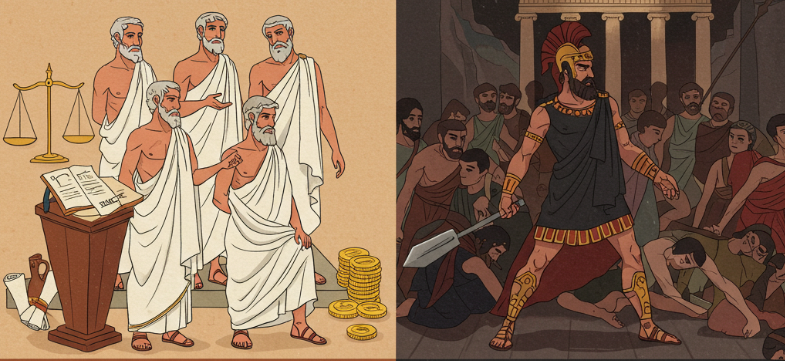Ancient Greece was home to a variety of political systems, each shaping the development of its city-states in unique ways. Two of the most prominent forms of government were oligarchy and tyranny—both forms of rule that concentrated power in the hands of a few, yet vastly different in their structure and impact. This article explores the key differences and similarities between these two systems, examining how they functioned across different Greek city-states.
Oligarchy: Rule by the Few
Oligarchy, derived from the Greek words oligos (few) and archē (rule), referred to a government where power was held by a small group, often wealthy aristocrats or influential elites. This system was particularly common in cities like Sparta, where governance was controlled by a dual kingship, a council of elders (Gerousia), and a group of five overseers (Ephors). In such systems, power was typically hereditary or tied to land ownership and wealth.
Characteristics of Oligarchy:
Power was concentrated among aristocrats or a select elite.
Decision-making was often slow and deliberate, as policies required consensus among ruling elites.
Social mobility was limited, as political power was tied to wealth and lineage.
Common citizens had little say in governance, leading to occasional unrest.
While oligarchies were generally stable, they often fostered resentment among the lower classes, who had little influence over political decisions. In many cases, discontent with oligarchic rule led to revolts or the rise of tyrants.
Tyranny: Rule by a Single Leader
Tyranny in ancient Greece did not always carry the negative connotation it has today. A tyrant was an individual who seized power outside traditional hereditary or legal means—often rising to power by championing the lower classes against aristocratic rule. City-states like Corinth and Athens experienced periods of tyranny, with leaders such as Cypselus of Corinth and Pisistratus of Athens gaining control through popular support.
Characteristics of Tyranny:
Rule was centralized under one person, who often took power through force or political maneuvering.
Many tyrants gained popular support by redistributing land, reducing taxes, or funding public works.
Unlike kings, tyrants did not inherit power but often relied on military strength or populist policies to maintain control.
Tyrannies were often short-lived, as successors struggled to maintain the same level of popular support.
While some tyrants were benevolent rulers who improved infrastructure and promoted cultural development, others became oppressive, leading to their eventual overthrow. Tyrannies were generally unstable, as power depended heavily on the ruler's personal ability to maintain control.
Key Differences and Similarities
Conclusion
Both oligarchy and tyranny shaped the political landscape of ancient Greece, each with its own advantages and flaws. While oligarchies maintained stability through controlled governance, they often led to social unrest due to their exclusivity. Tyrannies, on the other hand, could bring rapid reforms and economic relief but were prone to instability and internal conflict. Ultimately, dissatisfaction with these systems contributed to the rise of democracy in Athens, proving that Greek city-states were constantly evolving in their search for the ideal government.










